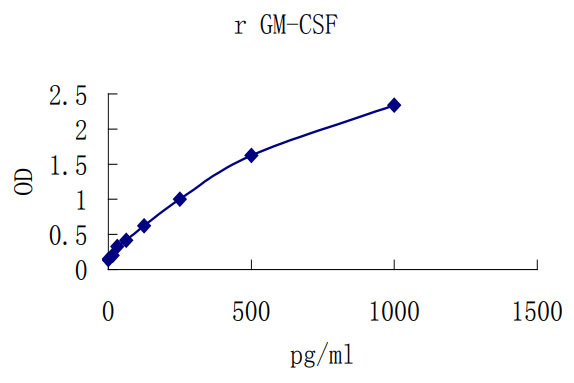Product Detail
Product NameRat GM-CSF ELISA kit
ApplicationsELISA
Species ReactivityRt
SpecificityNatural and recombinant Rat GM-CSF Ligand
Target NameRat GM-CSF
Application Details
Detect Range: 0.02 - 1.0 ng/mL
Sensitivity: 7pg/mL
Sample Type: Cell culture supernatant, serum, plasma (EDTA, citrate, heparin)
Sample Volume: 20 uL
Assay Time: 3 hour
Detection method: Colorimetric
GM-CSF was initially characterized as a factor that can support the in vitro colony formation of granulocytemacrophage progenitors. It is also a growth factor for erythroid, megakaryocyte, and eosinophil progenitors. GM-CSF is produced by a number of different cell types (including T cells, B cells, macrophages, mast cells, endothelial cells, fibroblasts, and adipocytes) in response to cytokine or inflammatory stimuli. On mature hematopoietic cells, GM-CSF is a survival factor for and activates the effector functions of granulocytes, monocytes/macrophages, and eosinophils (1, 2). GM-CSF promotes a Th1 biased immune response, angiogenesis, allergic inflammation, and the development of autoimmunity (3-5). It shows clinical effectiveness in ameliorating chemotherapyinduced neutropenia, and GM-CSF transfected tumor cells are utilized as cancer vaccines (6, 7). The 22 kDa glycosylated GM-CSF, similar to IL-3 and IL-5, is a cytokine with a core of four bundled αhelices(8-10). Mature rat GM-CSF shares 56-69% amino acid sequence identity with canine, feline, human, mouse, and porcine GM-CSF. GM-CSF exerts its biological effects through a heterodimeric receptor complex composed of GM-CSF Rα/CD116 and the signal transducing common β chain (CD131) which is also a component of the highaffinity receptors for IL-3 and IL-5 (11, 12). In addition, GM-CSF binds a naturally occurring soluble form of GM-CSF Rα (13). Rat GM-CSF is active on mouse cells, although mouse GM-CSF is only weakly active on rat cells (14, 15).



 YES
YES



